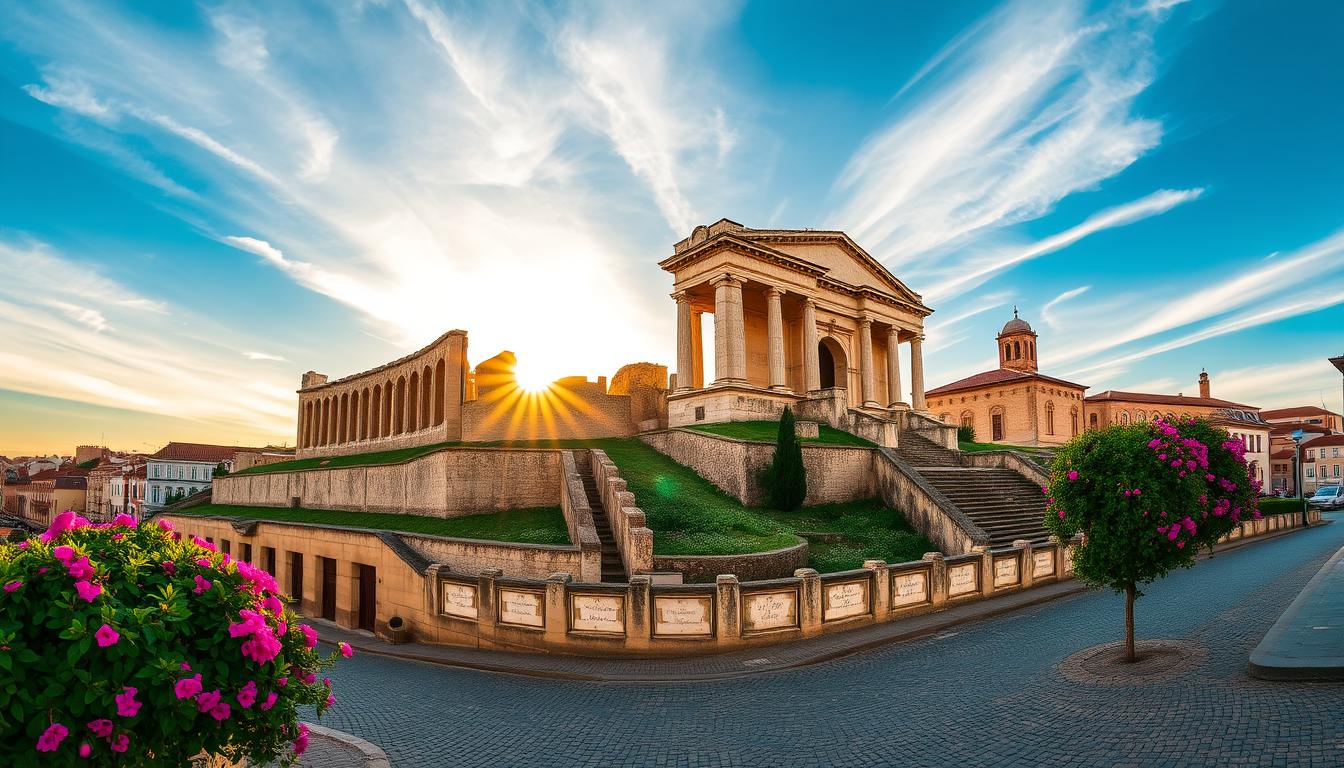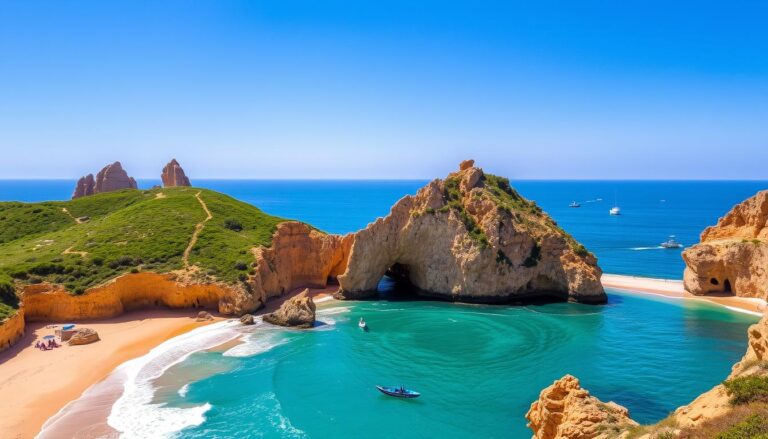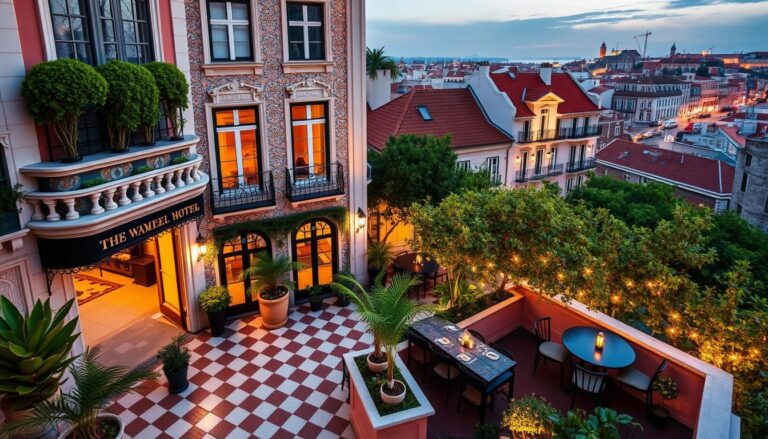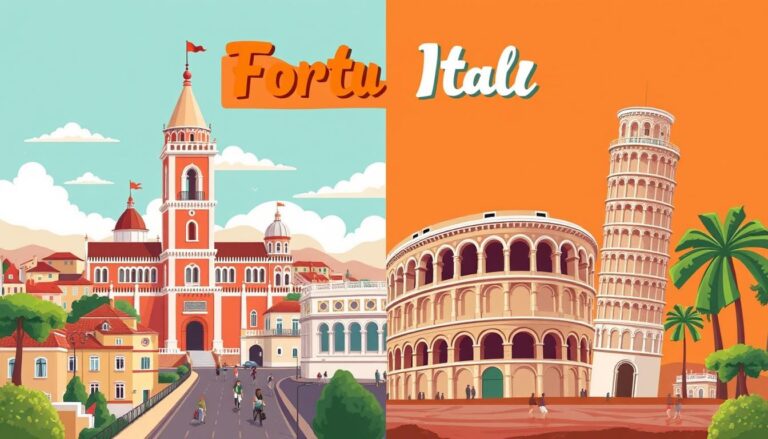Evora, Portugal: A Captivating Historic Gem
Imagine walking through a living museum where every stone tells a story. Evora Portugal, is a place where history and culture meet. It’s a UNESCO World Heritage site in the Alentejo region, ready to take you on a journey through time.
Evora’s history is as old as 2,000 years. It’s just 1.5 hours from Lisbon. This city shows off buildings from Romans, Moors, and Portuguese, each leaving their mark. Every wall and street tells a story, inviting you to explore.
As the 2027 European Capital of Culture, Evora is a symbol of preservation and art. Its buildings and monuments are like a living painting, captivating all who visit.
Evora is home to sights like the Temple of Diana and the Chapel of Bones. These places offer a unique experience that goes beyond usual tourist spots. You’ll see amazing architecture, taste delicious food, and connect with Portugal’s heritage.
Table of Contents
Overview of Evora, Portugal
Evora, Portugal, is in the heart of the Alentejo region. It’s a city with a long history, over 5,000 years. It’s known for its well-preserved buildings and history.
The history of Evora is a story of change. It started with Celtic tribes and became a cultural hub. Here are the key moments in its history:
- Founded by Celtic tribes around 8th century BC
- Conquered by Romans in 57 BC
- Experienced Moorish rule from 715 to 1165
- Reconquered by King Alfonso I in 1166
A City of Historical Significance
Evora is about 80 miles east of Lisbon. It became a center of learning in the 15th century. Scholars and royalty came from all over Portugal.
| Historical Period | Key Developments |
|---|---|
| Celtic Period | Initial settlement established |
| Roman Era | Construction of Roman Temple (1st century AD) |
| Medieval Period | Construction of Cathedral (1186-1204) |
| Renaissance | Became a center of arts and learning |
UNESCO World Heritage Recognition
Today, Evora is a UNESCO World Heritage Site. It keeps its history alive. The city’s center, with its medieval walls, shows Portugal’s past.
Evora has about 50,000 people. It’s the biggest city in Alentejo. It’s a place that inspires and amazes visitors from everywhere.
Key Attractions to Explore
Évora sightseeing takes you on a journey through time. It shows some of Portugal’s most amazing historical landmarks. This city is full of Evora attractions that will interest history lovers and culture seekers.
Exploring Évora’s iconic sites reveals a wealth of architectural wonders. These sites span many centuries. Each one shares a unique part of the city’s rich cultural story.
The Roman Temple of Évora: A Glimpse into Ancient History
This Roman temple is the best-preserved in the Iberian Peninsula. It dates back to the 1st century AD. Dedicated to a Roman emperor, it gives visitors a glimpse into ancient architectural brilliance.
- Located in the city center
- Approximately 2,000 years old
- Considered a top Evora attraction
Évora Cathedral: Architectural Magnificence
The largest cathedral in Portugal, Évora Cathedral is a mix of Romanesque and Gothic styles. Built from 1186 to 1250, it stands tall over the city.
| Cathedral Details | Information |
|---|---|
| Construction Period | 1186-1250 |
| Architectural Styles | Romanesque and Gothic |
| Admission Price | 4-5 Euros |
The Chapel of Bones: A Unique Philosophical Experience
Visiting the Chapel of Bones is a must in Évora. Franciscan monks built it in the 17th century. It holds the remains of over 5,000 people.
- Built to address cemetery overcrowding
- Philosophical message about mortality
- Admission fee: 6 Euros
Évora’s attractions make it a key destination for those wanting to dive into Portugal’s history.
Rich Cultural Heritage
Évora is a treasure trove of Portugal’s rich culture, drawing in visitors with its deep history. It’s known for its well-preserved buildings and cultural gems. This has made it a top spot for those who love history and culture.
Uncovering Évora’s UNESCO World Heritage Status
Exploring Évora’s history is like stepping back in time. The city boasts over 4,000 historical buildings, each telling a story of Portugal’s past. Its UNESCO World Heritage status celebrates its cultural treasures:
- Exceptional architectural preservation from Roman to Baroque periods
- Remarkable urban landscape maintaining historical integrity
- Significant examples of architectural styles throughout different eras
Traditional Festivals Celebrating Local Culture
Évora’s culture shines bright at its traditional festivals. The Feira de São João is one of Portugal’s oldest fairs. It brings together locals and visitors with music, food, and customs passed down through generations.
Visiting Évora’s attractions, you’ll see a city that values its history and traditions. From its UNESCO-recognized buildings to its lively festivals, Évora offers a unique look into Portuguese heritage.
Culinary Delights to Savor
Évora is a food lover’s dream, offering a deep dive into Alentejo cuisine. The city’s food scene is shaped by centuries of farming and local tastes. It promises to excite your senses.
Local Dishes You Must Try
In evora restaurants, you’ll find dishes that truly represent Portuguese cooking. Here are some dishes you can’t miss:
- Açorda à Alentejana: A traditional bread and garlic soup with poached eggs
- Migas: Crispy fried bread with aromatic spices
- Locally sourced lamb dishes
- Fresh regional cheeses
Best Restaurants in Evora
Finding the perfect place to eat in Évora can make your trip even better. Here are some top spots for authentic local food:
| Restaurant Name | Specialty | Price Range |
|---|---|---|
| Restaurante Fialho | Traditional Alentejo cuisine | $$ |
| Taberna Típica Quarta-Feira | Local farm-to-table dishes | $$$ |
| Dom Joaquim | Regional wine pairings | $$ |
Your food journey in Évora will be a memorable one. It’s a chance to explore flavors, traditions, and the warm welcome of the locals.
Best Times to Visit Evora
Planning your trip to Evora is all about timing. Knowing the best seasons can make your visit unforgettable.
Portugal has something for everyone all year round. Evora is especially great during certain times.
Seasonal Travel Insights
The best times to see Evora are in the shoulder seasons. These are:
- Early Spring (April to May)
- Autumn (September to November)
High Season vs. Low Season Breakdown
| Season | Characteristics | Traveler Experience |
|---|---|---|
| High Season (June-August) | Peak temperatures (78-83°F) | Large crowds, higher prices |
| Shoulder Season (April-June, September-November) | Mild temperatures, fewer tourists | Optimal sightseeing conditions |
| Low Season (December-April) | Cooler temperatures, potential rainfall | Lower prices, minimal crowds |
Weather Considerations for Travelers
Be aware of the weather when you visit Evora. Early spring is lovely with flowers and nice weather. Summer can be very hot, making it hard to explore.
Tip: Wear layers and comfy shoes for walking in Evora. The city’s history is waiting for you anytime!
Accommodation Options in Evora
Finding the right place to stay in Evora can make your trip better. The city has many hotels for all budgets. You can choose from old pousadas to cozy guesthouses, all with a touch of history.

In Evora, you can pick from fancy historical buildings to affordable stays. The city’s UNESCO World Heritage status adds beauty to even the cheapest places to stay.
Luxury Hotels in the City Center
For those looking for the best, Evora’s luxury hotels are top-notch. The Pousada Convento de Évora is a standout:
- Rooms made from old monk’s cells
- Rates start at 204€ per night
- Features like a swimming pool and free Wi-Fi
- A restaurant that can seat 80 people
Budget-Friendly Stays for Travelers
If you’re watching your budget, Evora has hotels that are easy on the wallet. Here are some options:
| Hotel Name | Price Range | Distance from City Center |
|---|---|---|
| Heaven Inn Suites & Terrace | $30/night | 0.1 mi |
| Stayinn City – Évora | $45/night | 0.1 mi |
| Burgos Guest House | $39/night | 0.0 mi |
Tip: Book during the off-season for cheaper rates. August is the priciest month. Your ideal Evora hotel is waiting, ready to make your stay unforgettable.
Getting Around Evora
Exploring Evora is a joy for those seeking a true Portuguese experience. This small city has many ways to get around. You can easily see its historic sites and the areas nearby.
Walking in the Historic Center
Walking is the best way to start your journey in Evora. The city’s old center is easy to walk around. You’ll feel like you’re stepping back in time.
Most sights are close by. You can easily visit:
- Roman Temple just steps away from Cathedral
- Chapel of Bones within short walking radius
- Compact street layout perfect for walking
Public Transport Options
Evora has a good public transport system. It’s cheap and helps you get around the city and nearby places. The Linha Azul bus network covers key areas:
| Route | Frequency | Cost |
|---|---|---|
| Linha Azul Norte | Every 15 minutes | €1.50 per trip |
| Linha Azul Sud | Every 15 minutes | €1.15 reduced fare |
Renting a Car for Exploration
If you want to see more of the Alentejo region, rent a car. It gives you freedom to explore. You can easily reach:
- Estremoz: 40 minutes away
- Monsaraz: Approximately 2.5 hours
- Arraiolos: 30-minute drive
Don’t forget your international driving permit. Also, know the driving rules in Portugal. Parking in the old center can be tough, so use the parking lots.
Train Connections
Evora is connected to Lisbon by train. Trains run often, making the trip scenic and comfy:
- Weekday departures from Lisbon: 5 trains
- Weekend departures: 3 trains
- One-way ticket prices: €13.60 (second class)
Your Evora travel guide suggests choosing your transport wisely. Whether walking, using buses, or driving, there’s a way to see the city’s beauty.
Day Trips from Evora
Exploring the Alentejo region around Evora is a great chance to see Portugal’s rich culture and nature. Your trips can go beyond the city, showing you a beautiful countryside. It’s full of history and stunning views.
The Alentejo region has many interesting places to visit. These places make your trip to Evora even better. You can see medieval villages and beautiful natural parks.
Discovering the Alentejo Region
There are many amazing places to visit from Evora:
- Monsaraz: A beautiful medieval village with amazing views of the Alqueva Dam
- Corval: A famous place for pottery where you can see local artists at work
- Local wineries where you can taste the region’s great wines
- Olive oil producers showing how they make traditional olive oil
Visiting Nearby Monuments and Parks
Nature lovers will love the areas around Evora. The Serra d’Ossa is great for hiking and birdwatching. It lets you enjoy the region’s natural beauty.
When planning your trips, think about how to get around:
- Rental car for more freedom
- Organized tours for convenience
- Public transport to big attractions
Most trips from Evora can be done in one day. They’re great for adding to your adventure in Portugal.
Tips for Traveling in Evora
Planning your trip to Evora means understanding its unique vibe. This historic city in Portugal is a gem in the Alentejo region. It offers a rich cultural experience and a warm welcome to visitors.

Exploring Evora can be amazing if you follow some key tips. The city moves at a slower pace, which is something to appreciate. Visitors should take their time and soak in the local atmosphere.
Essential Dos and Don’ts
- Do dress modestly when visiting religious sites
- Don’t rush through meals – embrace the local dining culture
- Respect siesta times (typically between 2-5 PM)
- Always carry some cash for smaller establishments
- Learn a few basic Portuguese phrases
Language and Communication Insights
While Portuguese is the main language, many locals speak some English in tourist areas. Here are some tips for communication:
- Learn basic greetings like Bom dia (Good morning) and Obrigado/a (Thank you)
- Use translation apps for more complex conversations
- Be patient and respectful when communicating
| Travel Tip | Recommendation |
|---|---|
| Local Transportation | Walking is best within city walls; buses for longer distances |
| Dining Etiquette | Tip 5-10% in restaurants, round up taxi fares |
| Safety | Evora is generally safe, but stay aware of personal belongings |
Evora is a small city with about 56,000 people. It offers a close and personal travel experience. Enjoy the local culture, take your time, and discover the charm of this UNESCO World Heritage Site.
Evora’s Vibrant Arts Scene
Evora is a cultural gem in Portugal, offering a deep dive into its rich artistic world. The city’s galleries, performance spaces, and historic venues showcase its creative spirit. It’s a top spot for art lovers to explore.
Art enthusiasts will find a wealth of experiences in Evora. The city’s art scene combines history and modern creativity. The University of Évora is key, hosting many exhibitions and events all year.
Local Art Galleries and Exhibitions
Discover Evora’s varied art scene in its standout galleries:
- Évora Museum: Showcases art from ancient to modern times
- University Art Gallery: Features work by students and professionals
- Galeria de Arte Contemporânea: Showcases modern Portuguese art
Music and Performing Arts in Evora
Evora’s performing arts scene is lively, with both traditional and modern shows. You can enjoy classical concerts in old churches or modern music festivals. It’s a city that offers a rich cultural experience.
- Évora International Short Film Festival: Celebrates short films every autumn
- Classical music in historic churches
- Street performances in Praça do Giraldo
Whether you love visual arts or music, Evora’s arts scene is unforgettable. It’s a journey through Portugal’s cultural heritage.
Navigating Cultural Etiquette
Exploring Evora is more fun when you know the local customs. Your Evora travel guide suggests embracing the warm Portuguese ways. These customs make the historic region special. Showing interest in their traditions is key, especially in social interactions and communication.
“Saudade” is a big part of Evora’s culture. It’s about deep emotional connections to history and place. When you meet locals, be respectful and take your time. Learning a few Portuguese phrases shows you care about their culture.
Small actions, like saying “Bom dia” (Good morning), can make a big difference. Social life in Evora values relationships over time. Enjoy long talks and be patient. Asking about local traditions, like cork and olive oil, shows you’re interested in their heritage.
Gift-giving is a big deal in Evora. Bringing a small gift, like local wine or sweets, is a nice gesture. It shows respect and appreciation. Being open and respectful makes your trip to Evora unforgettable.







